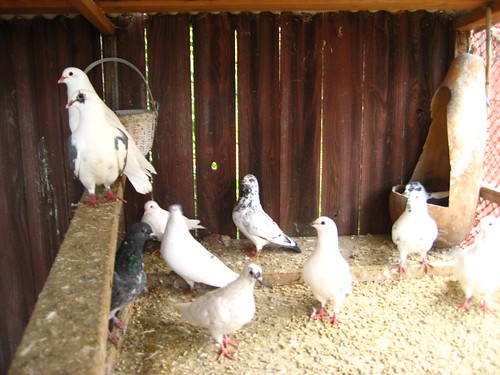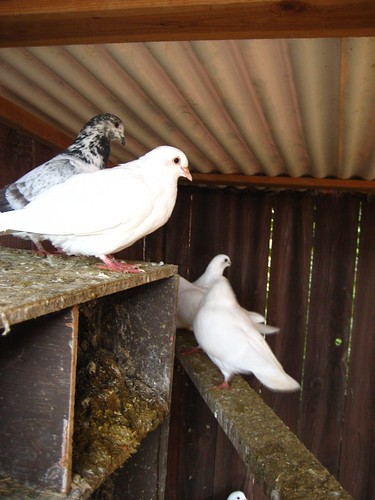
-Pigeons: carrying your messages and your meal all in one feathered package.-
Pigeons aren't exactly what we would call haute cuisine in the United States. For the most part they're seen as dirty animals. Rats with wings. They carry disease and spread plague. Which is odd because I can't say I can name a single disease carried by pigeons (maybe bird flu, but that we can't place that burden solely on the shoulders of pigeons). I can't recall any great health disaster that was due to pigeons, unlike say the fleas and rats who were the initial carriers of the Black Death or mosquitoes and their ubiquitous association with malaria.
It seems then that pigeons have gotten a bad rap in the food world amongst Anglo America. They're a pariah. A guest most unwelcome to dinner either as a guest or the main course.
Yet for the most part, many of us have happily eaten it anyways. Ah, the power of nomenclature. It's far easier to sell Patagonian Toothfish as Chilean Sea Bass as it doesn't have that barbaric image recalling ideas of gnarly fishes with awful spines and slimy flesh. A bottom feeder of the like that would butcher you in the water given a aluminum bat and half the chance. Chinese gooseberries sound foreign and odd, like that aunt no one ever wants to talk about. Repackage those bastards as kiwis - much cuter! Far more profitable as well!
I speak, of course, of squab, the more pleasant name for pigeon.
Then there is the case of doves. Doves, hierarchically and scientifically categorically speaking, are only a stones throw away from pigeons. They're in the same family, Columbidae. If you're talking about one then you're most certainly talking about the other.
If pigeons are dirty it's more likely due to the gross amount of human food and refuse they ingest than anything else. Who would want to eat anything raised on tossed bits of cheese puffs, Wonder bread, and strewn bits of Cheerios that failed to make it into a toddler's mouth?
Assuming we look at wild pigeons and doves then we can see their main diet consists of a variety of seeds and fruits. The perfect diet of a creature whom you would like to eat. This equals dark and tasty meat that, when stuffed with citrus and grapes and tossed over a grill (see, Hank, I pay attention) can equal some of the most delightful tasting bird you've ever tasted. Gamey, sprightly, and a bit woodsy in flavor.
Furthermore, it's more and more common for people to begin keeping them in roosts for food even within major cities. Uncommon are the days where city chickens, ducks, and geese were a novelty. Urban farming and bird raising for the purpose of eggs and meat has become a regular scene. It only makes sense that pigeons be as well.
And why not? Rock Pigeons, Wood Pigeons, turtledoves, and white doves are all now commonly kept in roosts by all sorts of families within the United States, though mostly by immigrant groups. In fact, the Passenger Pigeon is extinct in North America due to it's being hunted out for its tasty breasts by white settlers, so Anglo Americans have a history of eating pigeon meat.
Aside from these reasons there are plenty of religious ones to feast on these tasty turtledoves. According to the Tanakh, doves and pigeons are totally kosher (and perfect when rubbed with kosher salt, seared, and tossed into the oven). Second, within the Jewish faith they're the only birds that can be used for a korban (a type of sacrificial offering described in the Torah).
I recently was able to talk to my friend Sheng, the author of the only Hmong cookbook ever published, about the subject. Her family keeps a pigeon roost in their backyard for food. They're sustained on a seed mixture and a variety of healthy breads and bits of leftover fruit and vegetables. This, plus a large roost that gives them plenty of space to exercise makes for huge, hearty birds with lots of fat and meat to them.
The only thing dirty about them was their cage, which was totally, completely covered in bird shit. I mean were talking about a good multicolored crust of bird shit on the ground. But that's what kept birds do. They shit on stuff. If you want to call that dirty, then you're being cynical as all pets do this and as their owners we pick up after them. True, you might not eat Sparky so doesn't that make pigeons different? Not really, you have to pluck and clean the birds as it is, therefore cleaning any outside filth off. The birds are perfectly clean.
Tasty too.
Overall, I'm not sure how much of an authority I can really be on the subject. You should read Hank's blog for all things animal as he can better communicate the awesomeness of pigeon raising, hunting, cooking, and eating. I just know that if offered I'll never turn down pigeon.

-I shall name you Breakfast, Lunch, Dinner, Snack, and Extra Meal in the Day When I Get Bored and Begin to Eat Out of Habit.-









My grandparents raised pigeons when I was growing up, and there is nothing tastier than a fresh pigeon egg. For some reason we never ate the meat (come to think of it, I have no idea why they raised them), but I certainly would have given it a try.
ReplyDeleteDude, you are in my brain! I roasted a few pigeons last week and am planning on posting on All Things Pigeon later this week! Go figger.
ReplyDeleteYou also might mention that the "squab" on many haute menus -- i.e., the French Laundry -- is in fact a pigeon. The largest squab producer in the US is a friend of mine named Bob Shipley from Modesto. Nice guy.
Thanks for the shout-out on pigeony goodness -- I'll pick up the conversation in a few days...
hank
Hurrah for squab! Love it glazed and grilled with polenta. Wish it was on menus much more often, and in markets (which I have yet to see one day, but often I'm just happy to see a rabbit.) Great post!
ReplyDeleteThey also carry West Nile Virus! And Salmonella species! And Campylobacter jejuni! Etc. (Sorry to burst that bubble, but there are no food animals that do not carry some sort of zoonotic disease).
ReplyDeleteI'll still eat them, though. The farmers' market here in Edinburgh has one stall that sells only a huge variety of savoury and sweet pies, and my hubby, toddler son and I adore all their game pies, including the wood pigeon and pheasant one. Yum!
Wonderful! We have been seeking out some smaller birds for cooking. Thank you for this fantastic post.
ReplyDeleteWE used to have pigeons here at home but we don't have it anymore. We usually marinate them in soy sauce and fry them. Great post, as always.
ReplyDeleteI remember one time sitting at an outdoor restaurant with many pigeons underfoot. My friend stared one in the eye and said to it, "you look yummy!"
ReplyDeleteThe also cause Q fever (not making this up) but only if you come into contact with the feces. So eating them shouldn't be a problem.
ReplyDeleteI say let's eat anything that moves!
ReplyDeleterain-deers, horses, ostriches, chinchillas, rats, ah, heck if it moves it's good enough to eat
One of the best meals I ever ate was pigeon in Champagne, France--I suppose it survived on those amazing grapes while alive--I never would have ordered it had the waiter not practically insisted, but my mind has forever been changed on the "squab." Delicious!!!
ReplyDeleteHi I love turkey pigeon world's most beautiful animals I think I have associations which gives people peace of mind.
ReplyDeleteMinced squab in lettuce cups is my mom and my husband's favorite dish at our favorite Chinese restaurant in Monterey Park (aka the modern Chinatown of LA). Pigeon, bamboo shoots, shitaake mushrooms, bean sprouts, and a variety of other unidentifiable items, minced and stir fryed, in a leaf of iceberg lettuce with hoisin sauce. So good! PF Chang's tries to copy it using chicken and it loses all of its awesome flavor. I would love to try squab in another dish!
ReplyDelete